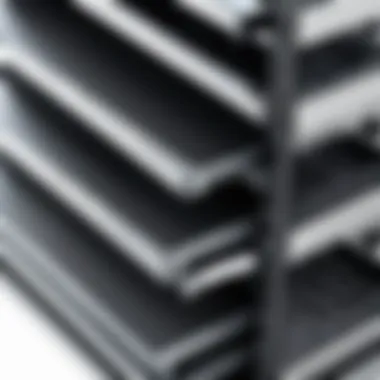Heavy Duty Rack Mount Shelf: Comprehensive Guide


Intro
Heavy-duty rack mount shelves play a critical role in the organization and management of electronic equipment. With the rise of dense technology environments, especially in data centers and server rooms, the need for reliable shelving solutions has become essential. These shelves provide the support necessary for various equipment, ensuring both safety and accessibility.
As technology advances and equipment becomes more complex, the understanding of rack mount shelves is vital for both tech enthusiasts and professionals in the field. This article aims to guide you through the key elements, specifications, and applications of heavy-duty rack mount shelves.
Product Overview
Heavy-duty rack mount shelves are designed with strength and durability in mind. They can hold various types of equipment, from servers to networking gear. The design is generally standardized, making them compatible with most rack systems.
Key Features
- Sturdy Construction: Often made from steel or aluminum, providing long-lasting support.
- Adjustable Design: Many shelves offer adjustable height options for flexibility.
- Ventilation: Some models include ventilation features to prevent overheating.
- Load Capacity: Typically rated for various weight capacities, commonly ranging from 50 to 500 pounds depending on the model.
Technical Specifications
Understanding the technical specifications of these shelves is crucial for making informed choices.
- Dimensions: Common sizes include 1U, 2U, and larger, allowing compatibility with different rack heights.
- Weight Capacity: Confirm the maximum load capacity to prevent damage to both the shelf and the equipment.
- Material: Steel is preferred for its strength, while aluminum is lighter, making the choice dependent on the specific requirements of the setup.
Pricing Information
The price of heavy-duty rack mount shelves can vary widely based on features and material. Basic models may start around $50, while advanced options could reach upward of $300, depending on customization and load capacity.
Performance Analysis
Analyzing the performance of heavy-duty rack mount shelves helps in understanding their value in practical applications.
Benchmark Results
In terms of weight distribution and durability, results show these shelves maintain structural integrity under heavy loads. Real-life testing indicates that well-manufactured shelves can handle loads more than advertised.
Real-World Use Cases
Industries such as IT, telecommunications, and broadcasting often utilize heavy-duty rack mount shelves. They organize critical equipment in an efficient manner. For example, in a data center, servers are typically stacked vertically, where these shelves play a notable role in maximizing space.
Comparison with Competitors
When comparing heavy-duty rack mount shelves to standard shelves, the former often provide greater strength and versatility. Some competitors may offer cheaper alternatives, but they may lack the reliability and features that are critical for high-performance environments.
Installation and Setup
Installing a heavy-duty rack mount shelf requires careful consideration of the tools and methods involved.
Required Tools and Components
- Tools: Screwdrivers, wrenches, and possibly a drill for mounting.
- Hardware: Ensure you have screws, nuts, and any spacers needed for installation.
Step-by-Step Installation Guide
- Prepare the Rack: Ensure the rack is stable and at the proper height.
- Position the Shelf: Align the shelf with the mounting holes.
- Secure the Shelf: Use the appropriate screws and tighten them securely.
- Test Stability: Apply pressure to ensure the shelf is firmly in place.
Troubleshooting Common Issues
- Shelf Wobble: Check that all screws are properly tightened.
- Weight Limit Exceeded: If the shelf bends or shows signs of stress, redistribute the load.
Pros and Cons
Understanding the pros and cons of heavy-duty rack mount shelves aids in making an informed decision.
Advantages of the Product
- Strength: Ideal for heavy equipment.
- Customizability: Options for size and capacity.
- Safety Features: Generally come equipped with features to prevent equipment damage.
Disadvantages or Limitations
- Cost: Higher-end models can be pricey.
- Installation Difficulty: May require expertise or additional tools.
Who It’s Best Suited For
These shelves are best for IT professionals, data center managers, and organizations that require reliable organization for heavy equipment.
Final Thoughts
Summary of Key Points
Heavy-duty rack mount shelves are an essential component in managing electronic equipment. Their sturdy design and versatile applications make them ideal for various environments.


Recommendations for Potential Buyers
Consider your specific requirements regarding weight, size, and installation when selecting a shelf. Research different brands and read user reviews for additional insights.
Future of the Technology or Product Line
As technology evolves, rack mount shelves are likely to adapt, possibly incorporating smart features or materials. Continuous improvements will ensure they remain integral to organizational setups.
Prelims to Heavy Duty Rack Mount Shelves
Heavy duty rack mount shelves play a crucial role in the organization and management of electronic equipment. As our reliance on technology increases, effectively organizing and housing this equipment becomes more essential. These shelves not only provide structural support but also enhance accessibility and efficiency in space utilization. In environments such as data centers, server rooms, and even home offices, they are indispensable.
Definition and Purpose
A heavy duty rack mount shelf is a platform designed to hold equipment that is mounted within a server or data rack. The primary purpose of these shelves is to support various types of hardware, such as servers, network switches, and other electronic devices, which need to be securely housed. By providing a dedicated space, these shelves help in maintaining order and facilitating better airflow between devices. This contributes to the longevity and performance of the equipment.
Unlike standard shelves, heavy duty options are built to withstand significant weight, often supporting hundreds of pounds. This capability is particularly important in professional settings where maximizing space while ensuring stability is critical.
History of Rack Mount Solutions
The evolution of rack mount solutions traces back to the late 20th century, an era marked by rapid advancements in computing technology. Businesses began to adopt electronic equipment in larger volumes, necessitating effective ways to manage and organize it. The invention of the 19-inch rack standard in the 1970s became a defining moment, enabling various manufacturers to create compatible equipment that could be easily stored and accessed within these racks.
As technology progressed, so did the racks themselves. Heavy duty rack mount shelves emerged as a response to increased demands for higher weight capacities and sophisticated designs. Initially made of simple metals, advancements in materials science led to more durable and versatile options. This history illustrates the growing importance of heavy duty rack mount solutions in today’s tech landscape, reflecting both a need for organization and a method for maximizing efficiency in technology usage.
Types of Heavy Duty Rack Mount Shelves
Understanding the various types of heavy-duty rack mount shelves is essential for efficient organization and management of electronic equipment. Each type offers unique features and benefits that cater to different needs and applications. A good selection plays a critical role in maximizing space, ensuring safety, and maintaining accessibility.
Fixed Shelves
Fixed shelves are the most common type found in rack mount setups. They are installed on the rack at a single height and do not move. These shelves provide sturdy support for equipment that is not intended to be frequently accessed or adjusted.
Benefits of Fixed Shelves
- Stability: Their rigid installation helps maintain stability for heavy equipment.
- Ease of Installation: They are usually straightforward to install, requiring minimal tools.
- Cost-Effectiveness: Fixed shelves generally come at a lower price point compared to other types.
One common usage of fixed shelves is in data centers where servers and networking equipment can be continuously accessed without the need for mobility. Fixed shelves ensure the overloud weight from multiple devices can be adequately supported, preventing potential damage. However, it's crucial to consider the weight limit specified by the manufacturer, ensuring compliance with safety standards.
Sliding Shelves
Sliding shelves come with a mechanism that allows them to extend out of the rack for easy access. This feature is particularly useful for equipment that may need frequent adjustment or service.
Advantages of Sliding Shelves
- Accessibility: Users can easily access devices without reaching deep into the rack, which improves workflow efficiency.
- Flexibility: Allows for quick adjustments or maintenance without dismantling the entire setup.
- Maximized Space Usage: They enable more efficient use of space in tight configurations.
Sliding shelves are commonly used in environments where certain devices require regular handling. For example, in home setups or small studios, media equipment can be organized effectively without causing disruption to other items in the rack.
Cantilever Shelves
Cantilever shelves operate differently from fixed or sliding designs. They extend outwards from a single support point without posting a frame underneath. This design can accommodate larger equipment that may not fit well on traditional shelving.
Key Characteristics of Cantilever Shelves
- Versatile Configuration: They can hold bulky items easily, making them suitable for various applications, including audio equipment and large network switches.
- Unobstructed Space: Since they require minimal support, the shelving allows for more unobstructed space in the rack.
- Customizability: Custom sizes can often be accommodated, providing a tailored fit for unique setups.
It's important to assess the weight capacity when selecting cantilever shelves, as overloading can lead to failures. These shelves can often be found in specialized technical environments where equipment sizes and weights vary significantly.
Understanding these shelf types and their respective benefits allows users to align their selections with specific needs, providing organization and support for complex setups.
Material Considerations
Understanding the material used in heavy-duty rack mount shelves is crucial for ensuring efficiency, longevity, and performance. The choice between different materials can impact the overall strength, weight capacity, and suitability for various environments. Since these shelves often support valuable electronic equipment, selecting the correct material becomes a significant consideration.
Metal vs.
Wood
When evaluating materials, metal and wood stand out as the most common options. Each has its own set of advantages and disadvantages.
Metal shelves are favored for their durability and strength. Typically made from steel or aluminum, they can withstand significant weight without bending or warping. Their surfaces are often coated to prevent corrosion, making them ideal for data centers where equipment needs protection against the elements. Metal also offers a more modern aesthetic, which can complement high-tech setups.
On the other hand, wood shelves provide a different appeal. They have a classic look and can be easier to work with when it comes to customization. Wood offers warmth in design and can absorb shock well. However, its durability under heavy loads may be a concern, especially compared to metal. Moreover, it can be susceptible to environmental factors like humidity, which may cause warping or decay over time.
Both materials have their place, and the choice largely depends on the specific application and environment. For static, high-weight applications, metal shelves may be superior. For lighter-use situations or aesthetics, wood can be a viable solution.
Weight Capacity and Durability
Weight capacity is another critical factor when choosing a heavy-duty rack mount shelf. Each type of shelf will have a different rating, which dictates the maximum load it can safely handle. This rating is influenced by the shelf material and design. Generally, metal shelves exhibit higher weight capacities compared to wood counterparts. For example, a metal shelf might support up to 800 pounds, while a wooden shelf may only manage around 500 pounds.


Durability plays a pivotal role in maintaining performance over time. A shelf with high durability will resist deformation and damage, ensuring it continues to function as intended. Metal's resistance to wear and tear makes it a top choice in environments where heavy equipment is often loaded or unloaded.
Factors that affect durability also include:
- Environmental exposure (e.g., humidity, temperature)
- Frequency of load changes
- Usage type (e.g., intermittent vs. continuous load)
Maintaining awareness of these factors ensures that the selected rack mount shelf will perform effectively, safeguarding valuable equipment.
Selecting the right material and considering weight capacity will save you from potential equipment damage and replacement costs in the future.
Design Specifications
Design specifications for heavy-duty rack mount shelves are crucial in determining how effectively these units can support various types of equipment. A well-designed shelf not only provides stability but also enhances the overall usability of a space managed by electronic components. Understanding these specifications is essential for selecting the right shelf to meet one’s specific needs.
Standard Dimensions
Standard dimensions for heavy-duty rack mount shelves generally conform to industry norms, which ensure compatibility with most rack systems. The dimensions usually include width, depth, and height.
- Width: The most common widths are 19 inches and 23 inches, corresponding to standard rack sizes. These measurements provide ample space for mounting various devices.
- Depth: Typical depths range from 16 inches to 30 inches, depending on the equipment's form factor. Choosing the correct depth is vital to prevent any overhang that could affect stability.
- Height: Shelves usually come in units measured in rack space (U), with one U being 1.75 inches. It's essential to calculate height based on the number of devices and their collective height to prevent overcrowding.
By maintaining the standard dimensions, users can ensure their equipment fits properly and functions optimally within the rack system.
Customization Options
Customization options for heavy-duty rack mount shelves allow for tailored solutions that meet specific requirements. Customization can involve several aspects, including:
- Material Selection: While most shelves are made of metal, options for wood or composite materials exist. Depending on the weight of equipment and aesthetic preferences, the right material can greatly influence both durability and visual appeal.
- Load Capacity: Depending on the intended use, shelves can be designed to support varying amounts of weight. Some shelves can handle hundreds of pounds, making them suitable for heavy servers or networking equipment.
- Finishes and Colors: Aesthetic customization, including color options and finishes, is increasingly important, especially in environments like offices or data centers where appearance matters.
- Additional Features: Options may include features like cable management, ventilation holes, or reconfigurable layouts to enhance functionality.
Customizing a rack mount shelf to suit individual needs can significantly optimize performance and user experience.
In summary, both standard dimensions and customization options play an integral role in ensuring the effectiveness of rack mount shelves in organizing valuable electronic equipment. Selecting the right specifications can enhance both the utility and aesthetics of a set-up, ultimately leading to a more efficient workspace.
Installation Techniques
Understanding proper installation techniques for heavy-duty rack mount shelves is crucial for ensuring both functionality and safety. An effectively mounted shelf can enhance the performance of any electronic gear and contribute to a more organized workspace. On the contrary, poor installation can lead to equipment damage or even personal injury. This section sheds light on key components of the installation process.
Tools Required
Before you begin installing a heavy-duty rack mount shelf, it is essential to have the right tools at hand. Here are the common tools you will need:
- Drill: For creating mounting holes in the rack frame.
- Screwdriver: To tighten screws and ensure used hardware is secure.
- Level: To verify the shelf is positioned evenly.
- Measuring tape: For accurate measurements on placements.
- Stud finder: Useful for locating secure attachment points.
Using these tools guarantees that your installation is both efficient and safe, which is of utmost importance as any imperfection can interfere with the shelf's stability.
Mounting Procedures
Now that you have all necessary tools, it is time to install your rack mount shelf. Follow these steps to ensure a smooth process:
- Preparation: Clear the area around the rack. Make sure the rack is empty and there are no obstructions.
- Measurement: Use your measuring tape to determine the height where you want to mount the shelf. Mark these points with a pencil.
- Leveling: Take your level and double-check the marked points to ensure they align properly. This step avoids any slant in the installation, prolonging the shelf's life.
- Drilling: If your rack requires new holes for the installation, use the drill to create those holes carefully.
- Mounting: Attach the shelf to the rack using screws. Follow the manufacturer’s guidelines for recommended screw types and quantities. This ensures that the shelf can handle its intended load.
- Final Check: Once installed, do one last measurement to confirm that everything is properly aligned. Check to ensure all screws are tight and that the shelf feels secure.
Applications and Use Cases
The applications and use cases of heavy-duty rack mount shelves are pivotal in understanding their significance in various environments. These shelves provide crucial support for a wide array of electronic equipment. By assessing their applications, one can identify specific configurations and benefits that suit particular settings. Understanding these elements can lead to better organization, improved performance, and maximized efficiency in managing technology setups.
Data Centers
Data centers are one of the primary environments where heavy-duty rack mount shelves prove their worth. These facilities house a vast amount of server equipment, networking gear, and storage solutions. The reliability goes hand in hand with effective organization. Heavy-duty shelves offer a robust framework for mounting such equipment, facilitating easier access and maintenance.
There are several key benefits of using rack mount shelves in data centers:
- Space Optimization: These shelves allow for vertical stacking of heavy equipment, which saves valuable floor space in often cramped environments.
- Enhanced Airflow: Proper shelving reduces the chance of overheating by promoting better air circulation around the servers.
- Organized Infrastructure: Rack mount shelves prevent clutter, enabling clearer pathways for cables and devices, thus reducing the risk of accidental disconnections.
Adopting heavy-duty rack mount solutions ensures that data centers can maintain a streamlined and efficient operational flow. Performance, uptime, and organization all benefit when using specialized shelving solutions.
Home and Office Use
The need for heavy-duty rack mount shelves is not limited to professional or industrial settings. They also find practical applications in home and office environments. Whether it’s about setting up a gaming station or organizing office hardware, these shelves can make a difference.
In home and office settings, heavy-duty racks assist in the following ways:
- Accessibility: Such shelves allow for easy access to devices. Users can place monitors, gaming consoles, or other electronics within reach.
- Flexibility: Various configurations, including sliding shelves, facilitate better organization based on personal preferences or evolving needs.
- Aesthetic Appeal: Well-planned rack mount systems can enhance the look of a workspace or gaming area, combining functionality with style.
The growing trend of remote work makes it clear that having organized and effective setups at home is increasingly important. Implementing heavy-duty rack mount shelves is an impactful step toward achieving this efficiency.
"Proper organization and maintenance of technology infrastructure in both data centers and home environments can significantly affect performance and user experience."
Potential Issues and Solutions
In any technological setup, especially those utilizing heavy-duty rack mount shelves, understanding the potential challenges is vital. Knowledge of these issues helps users mitigate risks effectively. Not only do these solutions ensure safety, but they also enhance the longevity and effectiveness of the setup. In this section, we will detail two main concerns: overloading and proper maintenance and care.


Overloading Concerns
Overloading is one of the primary issues that can affect rack mount shelves. Every shelf has a specified weight capacity determined by manufacturing standards. Exceeding this limit can lead to structural failure, damaging the equipment and causing potential safety hazards.
It is essential to check the specifications of the shelf before installation. Heavy-duty racks, like those from APC and Tripp Lite, typically list the maximum load they can handle. Regularly monitor the weight distribution across all shelves. Uneven loads may not only strain a single shelf but can also compromise the rack's integrity.
Tips to Avoid Overloading:
- Calculate Load: Ensure that the combined weight of all equipment does not exceed the shelf rating.
- Use Load Spreading Equipment: For heavier items, consider using additional load-bearing accessories.
- Regular Inspections: Check for signs of strain or deformation in the shelf structure. If any issues arise, address them immediately.
Maintenance and Care
Proper maintenance is crucial to ensure the longevity and efficiency of heavy-duty rack mount shelves. Regular care can prevent many common problems, including damage from dust, moisture, or equipment wear.
To maintain these shelves, start with a regular cleaning routine. Dust and debris can accumulate and potentially impact electronic equipment. Using a damp cloth regularly to wipe down surfaces can keep racks in good condition.
Maintenance Practices:
- Inspect Regularly: Look for any signs of wear or damage. Tighten screws and fittings as necessary.
- Keep Dry: Moisture can lead to rust or corrosion. Ensure the area is well-ventilated and dry.
- Use Appropriate Cleaning Products: Avoid harsh chemicals that can scratch or damage surfaces. Stick to mild detergents.
Choosing the Right Rack Mount Shelf
Choosing the right rack mount shelf is a critical aspect of setting up any organized electronic environment. It provides the necessary support and accessibility for various equipment, ranging from servers to networking devices. The right choice affects not only the performance but also the longevity of your equipment. In this section, we will break down the process of selecting a suitable rack mount shelf, considering your specific needs and budget constraints.
Assessing Your Needs
The first step in selecting a rack mount shelf is to thoroughly assess your specific needs. Understanding your requirements includes evaluating the type of equipment you plan to store. Here are some key considerations:
- Weight Capacity: Each shelf comes with a specified weight limit. Ensure your choice can support the weight of the devices intended for it.
- Dimensions and Space: Measure the space available before making a purchase. Shelves should fit well within the rack without causing overcrowding.
- Accessibility: Consider whether you need shelves that slide out for easy access or fixed shelves that offer stability.
- Ventilation: Adequate airflow is essential for equipment health. Some shelves come with designs to promote better airflow.
Recognizing these factors will ensure that you choose a shelf that meets your functionality goals while making the best use of your space.
Budget Considerations
Budget is a significant factor when selecting a heavy-duty rack mount shelf. It’s essential to strike a balance between quality and cost. Here are some points to keep in mind:
- Quality vs. Price: Higher-priced shelves often bring better materials and support. Consider the long-term value of investing slightly more to avoid frequent replacements.
- Discounts and Bulk Purchases: Some suppliers offer discounts on bulk purchases. If you plan to outfit multiple racks, this could result in savings.
- Hidden Costs: Take into account any additional expenses such as installation fees or accessories needed for safety.
Putting thought into your budget will guide you toward the most suitable options without overspending. Remember, making an informed decision today can save you costs in the future.
Choose wisely; the right rack mount shelf can enhance efficiency and support for years to come.
Future Trends in Rack Mount Shelving
As technology evolves, so do the solutions that support it. Future trends in rack mount shelving focus on advanced developments that enhance performance and usability. This section discusses significant innovations, emphasizing how they improve functionality and address contemporary needs in various environments. Understanding these trends can provide insights into how rack mount shelves will continue to be pivotal in the organization of electronic equipment.
Innovations in Material Science
Material science is at the forefront of developing heavy-duty rack mount shelves. New materials improve strength while reducing weight. For example, the introduction of high-strength alloys and composite materials enables shelves to carry heavier loads without compromising stability. This enhanced load capacity directly influences how technology is organized in data centers and other tech-heavy settings.
Key features include:
- Lightweight composites reducing overall rack weight.
- High-strength alloys offering increased durability.
- Corrosion-resistant finishes ensuring longevity, especially in humid environments.
With these innovations, users can expect more customizability in shapes and sizes. This flexibility allows for more efficient use of space, adapting seamlessly to both professional data centers and casual home setups. Efficiency in weight and load-bearing capabilities can lead to thicker equipment being placed without fear of shelf failure.
Sustainability in Design
Sustainability has become a critical consideration in the production of rack mount shelves. Many manufacturers are shifting to eco-friendly materials and practices. For example, recycled metals are being used to create shelves, reducing the carbon footprint significantly. Furthermore, sustainable production processes minimize waste and energy consumption during manufacturing.
Benefits of sustainable designs include:
- Environmentally-friendly materials lowering ecological impact.
- Energy-efficient production practices reducing energy use.
- Long-lasting products decreasing frequency of replacements.
Adopting sustainability not only supports environmental efforts but can also appeal to consumers who prioritize green practices. Such trends indicate a growing expectation for accountability within the manufacturing sector.
The future of rack mount shelving is being driven by material innovation and sustainability, creating a landscape that's not just functional but also responsible.
As these trends develop, users are likely to see enhancements that not only improve the efficacy of the shelves but also consider their impact on the environment.
Culmination
The conclusion serves as a critical synthesis of the entire discussion on heavy-duty rack mount shelves. Throughout the article, we have emphasized their vital role in organizing and optimizing the management of electronic equipment, which is essential in both personal and professional settings.
Heavy-duty rack mount shelves offer various advantages, particularly in enhancing organization and accessibility. They accommodate a wide range of equipment from servers to audio-visual gear, ensuring that users can efficiently manage their setups. This is especially important in data centers, where space and efficiency are paramount.
Additionally, understanding the structural integrity and load-bearing capacity of these shelves helps users avoid overloading, which can lead to damaging both devices and infrastructure. By knowing the limitations and specifications, users can make informed choices that uphold the safety and efficiency of their arrangements.
Moreover, we have explored various materials, including metals and wood, that contribute to the durability and aesthetic appeal of these shelves. Each material has its own merits, and the choice depends on individual preferences and practical requirements. Customization is another aspect that cannot be overlooked. Tailoring rack mount shelves to fit specific setups enhances usability and effectiveness.
In summary, the significance of light and well-structured organization in technology setups cannot be understated. Heavy-duty rack mount shelves are fundamental tools that meet this need, allowing users to maximize their space, streamline workflows, and maintain the longevity of their electronic assets. As technology continues to advance, these shelves will invariably adapt, showcasing innovations and sustainable practices that align with modern standards.
The integration of heavy-duty rack mount shelves into electronic setups is a strategic choice that yields long-term benefits in organization, accessibility, and safety.
By recognizing the value they bring, readers are empowered to make sound decisions when integrating these vital components into their technology infrastructure.



